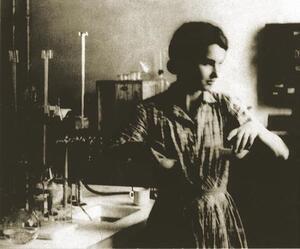Rosalind Elsie Franklin
Rosalind Elsie Franklin (1920 – 1958) unwittingly provided much of the foundation for James Watson and Francis Crick's "discovery" of the structure of DNA in 1953. Nine years later, Watson, Crick and Maurice Wilkins received the Nobel Prize in medicine for their joint findings. But because the Nobel Prize can be awarded only to the living, Franklin, who died of cancer at the age of 37, could not be honored. It was only during the 1990s that she received due credit for her extraordinary contributions to modern science. Franklin appears here in her Paris laboratory in 1950, at the end of four years spent studying in France.
Photographer: Vittorio Luzzati.
Institution: Retouching by: Winifred Kryda & Lynne Elkin.
Although her work formed the basis for Watson and Crick’s discovery of DNA, Rosalind Franklin was denied credit for decades. After graduating from Cambridge University in 1941, Franklin investigated the microstructure of coal for the British Coal Utilization Research Association from 1942–1946, work that led to her PhD from Cambridge in 1945. She perfected the technique of X-ray diffraction to map the irregular microstructure of coal at the Laboratoire Central des Services Chimiques de l’État from 1947–1950. She then returned to London, where she used her skills to attempt photographing DNA at a biophysics unit at King’s College. After personality clashes with another researcher, Maurice Wilkins, he showed her work to Watson and Crick without her knowledge, leading to their breakthrough and allowing them to submit their work for publication before her. She then rewrote her own paper, published in the same 1953 issue of Nature, to support and complement their work. Franklin left the lab that year, taking a position at Birkbeck College in London, where she changed focus to Tobacco Mosaic Virus and published prolifically on the structure of the virus’s RNA. She died of ovarian cancer at age 37. After many years, her role in the discovery of DNA was gradually acknowledged and honored by the scientific community, thanks to the efforts of her colleagues and friends.



